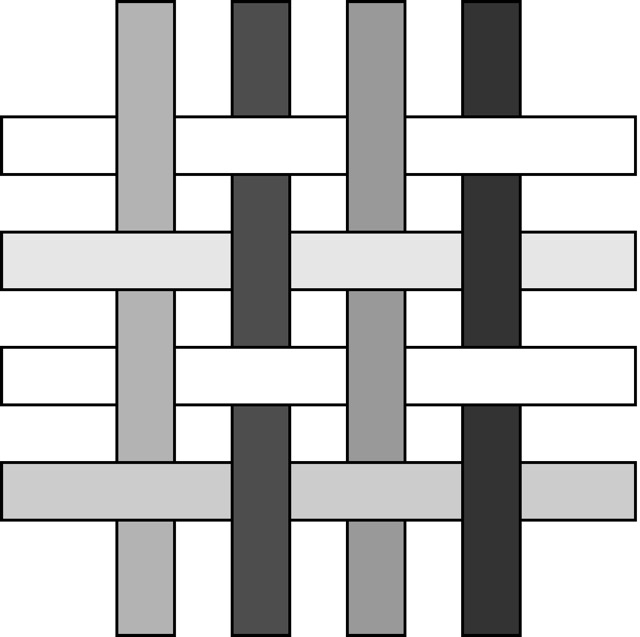| Codeforces Round 924 (Div. 2) |
|---|
| Finished |
Anya is engaged in needlework. Today she decided to knit a scarf from semi-transparent threads. Each thread is characterized by a single integer — the transparency coefficient.
The scarf is made according to the following scheme: horizontal threads with transparency coefficients $$$a_1, a_2, \ldots, a_n$$$ and vertical threads with transparency coefficients $$$b_1, b_2, \ldots, b_m$$$ are selected. Then they are interwoven as shown in the picture below, forming a piece of fabric of size $$$n \times m$$$, consisting of exactly $$$nm$$$ nodes:
 Example of a piece of fabric for $$$n = m = 4$$$.
Example of a piece of fabric for $$$n = m = 4$$$. After the interweaving tightens and there are no gaps between the threads, each node formed by a horizontal thread with number $$$i$$$ and a vertical thread with number $$$j$$$ will turn into a cell, which we will denote as $$$(i, j)$$$. Cell $$$(i, j)$$$ will have a transparency coefficient of $$$a_i + b_j$$$.
The interestingness of the resulting scarf will be the number of its sub-squares$$$^{\dagger}$$$ in which there are no pairs of neighboring$$$^{\dagger \dagger}$$$ cells with the same transparency coefficients.
Anya has not yet decided which threads to use for the scarf, so you will also be given $$$q$$$ queries to increase/decrease the coefficients for the threads on some ranges. After each query of which you need to output the interestingness of the resulting scarf.
$$$^{\dagger}$$$A sub-square of a piece of fabric is defined as the set of all its cells $$$(i, j)$$$, such that $$$x_0 \le i \le x_0 + d$$$ and $$$y_0 \le j \le y_0 + d$$$ for some integers $$$x_0$$$, $$$y_0$$$, and $$$d$$$ ($$$1 \le x_0 \le n - d$$$, $$$1 \le y_0 \le m - d$$$, $$$d \ge 0$$$).
$$$^{\dagger \dagger}$$$. Cells $$$(i_1, j_1)$$$ and $$$(i_2, j_2)$$$ are neighboring if and only if $$$|i_1 - i_2| + |j_1 - j_2| = 1$$$.
The first line contains three integers $$$n$$$, $$$m$$$, and $$$q$$$ ($$$1 \le n, m \le 3 \cdot 10^5$$$, $$$0 \le q \le 3 \cdot 10^5$$$) — the number of horizontal threads, the number of vertical threads, and the number of change requests.
The second line contains $$$n$$$ integers $$$a_1, a_2, \ldots, a_n$$$ ($$$-10^9 \le a_i \le 10^9$$$) — the transparency coefficients for the horizontal threads, with the threads numbered from top to bottom.
The third line contains $$$m$$$ integers $$$b_1, b_2, \ldots, b_m$$$ ($$$-10^9 \le b_i \le 10^9$$$) — the transparency coefficients for the vertical threads, with the threads numbered from left to right.
The next $$$q$$$ lines specify the change requests. Each request is described by a quadruple of integers $$$t$$$, $$$l$$$, $$$r$$$, and $$$x$$$ ($$$1 \le t \le 2$$$, $$$l \le r$$$, $$$-10^9 \le x \le 10^9$$$). Depending on the parameter $$$t$$$ in the request, the following actions are required:
- $$$t=1$$$. The transparency coefficients for the horizontal threads in the range $$$[l, r]$$$ are increased by $$$x$$$ (in other words, for all integers $$$l \le i \le r$$$, the value of $$$a_i$$$ is increased by $$$x$$$);
- $$$t=2$$$. The transparency coefficients for the vertical threads in the range $$$[l, r]$$$ are increased by $$$x$$$ (in other words, for all integers $$$l \le i \le r$$$, the value of $$$b_i$$$ is increased by $$$x$$$).
Output $$$(q+1)$$$ lines. In the $$$(i + 1)$$$-th line ($$$0 \le i \le q$$$), output a single integer — the interestingness of the scarf after applying the first $$$i$$$ requests.
4 4 01 1 2 31 2 2 3
20
3 3 21 1 12 2 81 2 3 12 2 3 -6
9 10 11
3 2 2-1000000000 0 1000000000-1000000000 10000000001 1 1 10000000002 2 2 -1000000000
8 7 7
In the first example, the transparency coefficients of the cells in the resulting plate are as follows:
| 2 | 3 | 3 | 4 |
| 2 | 3 | 3 | 4 |
| 3 | 4 | 4 | 5 |
| 4 | 5 | 5 | 6 |
Then there are the following sub-squares that do not contain two neighboring cells with the same transparency coefficient:
- Each of the $$$16$$$ cells separately;
- A sub-square with the upper left corner at cell $$$(3, 1)$$$ and the lower right corner at cell $$$(4, 2)$$$;
- A sub-square with the upper left corner at cell $$$(2, 3)$$$ and the lower right corner at cell $$$(3, 4)$$$;
- A sub-square with the upper left corner at cell $$$(2, 1)$$$ and the lower right corner at cell $$$(3, 2)$$$;
- A sub-square with the upper left corner at cell $$$(3, 3)$$$ and the lower right corner at cell $$$(4, 4)$$$.
In the second example, after the first query, the transparency coefficients of the horizontal threads are $$$[1, 2, 2]$$$. After the second query, the transparency coefficients of the vertical threads are $$$[2, -4, 2]$$$.
| Name |
|---|




